Art on campus
Our campus is home to an extensive range of public art. Explore the fascinating stories behind these public art works and discover them on campus.
Locations
A Spire
The British-Japanese artist Simon Fujiwara was born in London and grew up in Cornwall. He studied Architecture at the University of Cambridge from 2002-05 and Fine Art at the Städelschule Hochschule für Bildende Kunst in Frankfurt am Main from 2006-8. He is now based in Berlin. His first major British exhibition was at Tate St Ives in 2012.
Fujiwara adopts a quasi-anthropological approach in his practice and this work is his first Public Art commission. The commissioning committee, which included student and staff representation, sought to create a new outstanding feature at the very entrance of the University, in front of the new Laidlaw Library. Fujiwara’s work, A Spire, is a beacon and totem that evokes the industries on which the University, and indeed, the city, are largely built. A Spire is conceived as a soaring visual timeline Tall and cylindrical in form, A Spire is the third spire between two church buildings on Woodhouse Lane, drawing attention to the physical qualities of the site and creating a visually arresting moment on the campus. From the pulverised coal integrated at the base of the spire symbolising the coal on which Leeds’s prosperity was built, to the branches and cables laid into the cast, the surface of intertwined natural and technological elements symbolises the current digital era in which organic and man-made materials merge. A Spire creates a unique new presence at the top of Woodhouse Lane, capturing an ever changing vertical landscape and the passing of time.
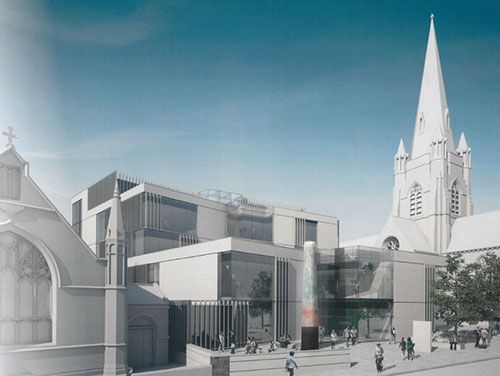
Tall and cylindrical in form, A Spire is the third spire between two church buildings on Woodhouse Lane, drawing attention to the physical qualities of the site and creating a visually arresting moment on the campus. From the pulverised coal integrated at the base of the spire symbolising the coal on which Leeds’s prosperity was built, to the branches and cables laid into the cast, the surface of intertwined natural and technological elements symbolises the current digital era in which organic and man-made materials merge. A Spire creates a unique new presence at the top of Woodhouse Lane, capturing an ever changing vertical landscape and the passing of time.
What3Words for A Spire artwork: ///object.focus.carry
Christ driving the moneychangers from the temple
A controversial figure, the devoutly religious Gill was born in Sussex and initially trained to be an architect. He abandoned his studies in 1903, eventually establishing himself as a sculptor, producing works with precise linear simplicity. In 1914 he was commissioned to create the Stations of the Cross for Westminster Cathedral. While working on these, Michael Sadler – then the University’s Vice-Chancellor – approached him to discuss a war memorial for Leeds. Gill revived a proposal rejected by the London County Council to commemorate their war dead, a freestanding bronze of Jesus and the Moneychangers.
For Leeds, Gill suggested a stone frieze, with Christ expelling a group of moneychangers from the temple– though with some in contemporary attire. In doing so, Gill was suggesting that the merchants of Leeds had profited from the war.
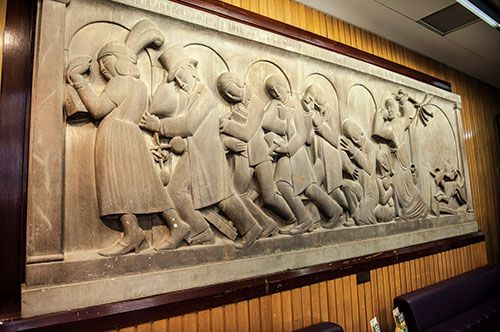
Gill’s relief was carved in five sections and was initially installed prominently on the wall beneath the University’s Great Hall. It was dedicated by the Bishop of Ripon on 1 June 1923. The subject matter was very different from that normally expected of memorials – soldiers or mourning angels – and caused immediate comment. The Yorkshire Post described it as a ‘curious monument which... promises to create much controversy’ and other local press agreed the work was ‘bizarre’, ‘puzzling’, ‘strange’ and ‘not appropriate’. Gill enjoyed the controversy and published his own defence of the work. Others rallied to defend it, including JRR Tolkien. Sadler himself steadfastly championed Gill’s masterpiece as ‘one of the finest things in modern art,’ adding ‘the carving will tell its own tale’. Subsequently, the weather took its toll on the work and ivy was allowed to grow over it, until the frieze was removed to a safer location in the foyer of the Michael Sadler building in 1961.
What3Words for Christ driving the moneychangers from the temple artwork: ///vent.epic.daring
Converse Column
Lijn specialises in kinetic or moving art. Her nine-metre revolving column features text that transforms with movement and is our newest edition on campus. Located outside Nexus, our new innovation hub, it represents communication and is designed to inspire collaboration. It was created with involvement from staff and students who contributed ideas for the words. Its arrival on campus coincided with the first Yorkshire Sculpture International.
What3Words for Converse Column artwork: ///verse.hurls.reap
Dual Form
Born in Wakefield, Yorkshire, in 1903 Barbara Hepworth enjoyed a lengthy career over 50 years. She is considered to be one of the most respected British sculptors of her era. Hepworth produced Dual Form in 1965, the same year she was made Dame Commander of the British Empire and also invited to be the first female trustee of the Tate Gallery - a position she would hold until 1972.
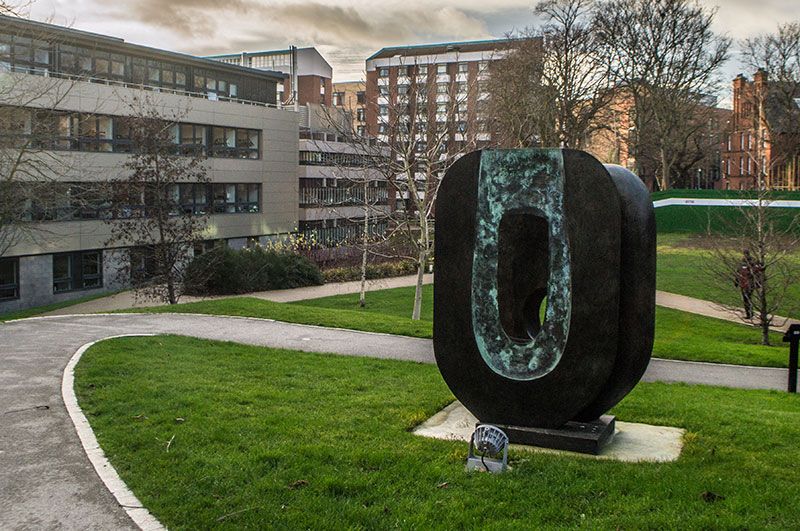
Dual Form is one of an edition of seven bronzes, a medium that Hepworth began working in towards the late 1950s. Despite her transition from working in wood to bronze, Dual Form reflects Hepworth's earlier style, with its simple form and pierced hollows.
What3Words for Dual Form artwork: ///flesh.learn.pens
Lenten Cover
Lyons was born in Bilston in Staffordshire and studied at Wolverhampton College of Art and the University of Newcastle. He was Head of Sculpture at Manchester Metropolitan University from 1989-93 and now lives and works in Yorkshire. His large scale public sculptures are sited in cities in China and Mexico and throughout Europe.
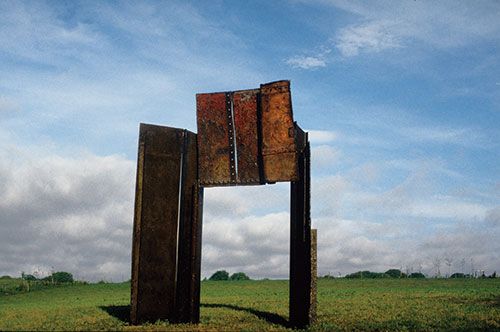
His Lenten Cover was completed on Good Friday 1979 and is made of steel plate sourced from scrap yards in Hull and Leeds. It reminded the artists of cloths covering church statues during Lent. This monumental piece creates a gateway from one place to another and was originally exhibited at the Serpentine Gallery, London, in Mold, at the Norwich Triennial and Margan Park, Port Talbot before being lent to the Ironbridge Open Air Museum of Steel Sculpture in 1991.
What3Words for Lenten Cover artwork: ///juices.swing.roofs
Limbo
Austin Wright grew up in Cardiff where he attended night classes at the Cardiff School of Art before studying Languages at New College, Oxford and pursuing a career as a teacher. He came to Yorkshire in 1937 and settled in Upper Poppleton with his wife Sue in 1946 and was based in the county for the remainder of his life. He created his sculptures in the barn and garden of their 18th century home and by 1954 had given up teaching to concentrate on his sculpture. Initially influenced by Moore and Hepworth in his early figures, he became known for his small lead figure groups and was, between 1961 and 1964, Gregory Fellow at the University of Leeds.
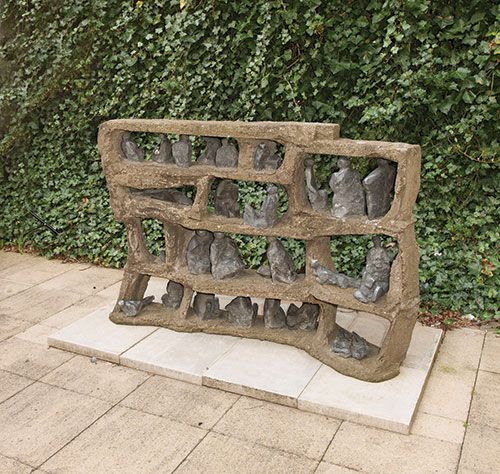
Limbo is a gathering together of 26 lead pieces created from drawings and observations made in sketchbooks on family seaside holidays in Anglesey and Cornwall in the 1950s. One particular drawing, dating from the early 1950s, is marked as Limbo and Praa (a beach on the south coast of Cornwall) and some of the figures relate directly to those in this sculpture, which for many years was displayed in the family garden at Upper Poppleton, on the corner of the patio.
What3Words for Limbo artwork: ///sleepy.page.carry
Man-made Fibres
The American sculptor Mitzi Cunliffe (née Solomon) was born in New York and is renowned for having designed the famous theatrical mask for the BAFTA (the British Academy of Film and Television Arts) award. Cunliffe was active as a designer of jewellery, textiles and glass, as well as teaching in later life. She studied Fine Art at Columbia University from 1935-40. In 1949, she came to England when she married a British academic and moved to Manchester. Her first large-scale public piece was created for the Festival of Britain in 1951 – Root Bodied Forth which was an 8-foot concrete group. In 1955, the same year she designed the famous BAFTA award, she was commissioned to create a major piece for the new Man-Made Fibres building at the University of Leeds. Professor JB Speakman, Head of the Department of Textile Industries, required a piece which would reflect the exciting progress in the field of synthetic fibres. Cunliffe submitted drawings and a maquette for a vast pair of hands with textile fibres crossed between them, to be executed in Portland stone. Man-Made Fibres was unveiled by the Duke of Edinburgh when the new building was opened in June 1956.

Cunliffe spent her entire working life bringing sculpture and architecture together. She wanted her work to be ‘used, rained on, leaned against, taken for granted’, declaring that her life-long dream ‘is a world where sculpture is produced by the yard in factories and used as casually as bricks’. In this case however, Man-Made Fibres is positioned so high on the Clothworkers’ Building South that it can easily be missed.
What3Words for Man-Made Fibres artwork: ///shark.shed.cult
Meet, Sit and Talk
Lorna Green is a sculptor and environmental artist based in Cheshire, who works in both urban and rural environments nationally and internationally. Her public art installations can be permanent or temporary and are often interactive. She did her MPhil at the University of Leeds and was a visiting lecturer in the School of Fine Art, History of Art and Cultural Studies from 1990 to 1997. In 1995 she was commissioned to create a site-specific sculpture for the Chancellor’s Court. Meet, Sit and Talk is made up of 3 stone circles, each stone bearing a rectangle of polished granite reflecting the sky and surrounding environment. Green explains the sculpture ‘is intended to be used - for sitting, for meeting at and to create a socially interactive space’ and students can be seen lunching and revising among the stones on sunny days. Green redesigned the whole area in collaboration with landscape architect Allan R. Ruff, who created a garden path recalling the flow of a river, the planting changing shape and colour as the seasons pass.
What3Words for Meet, Sit and Talk artwork: ///book.rots.wool
Sign for Art
Born in Birmingham, Wilson studied at Ruskin School of Art, Oxford, from 1985-88. He took his MA at the Slade, before teaching at the Royal College of Art, and he soon established a reputation as a sculptor with significant solo exhibitions at Camden Arts Centre, Compton Verney and the Wellcome Collection. He is currently Professor of Sculpture at Sheffield Hallam University.
Wilson’s best-known public artwork is Steles (Waterworks), an installation for the Olympic Park (2012). His practice involves ‘on-going enquiry into the contingency of meaning specifically in relation to the public functioning of sculpture’.
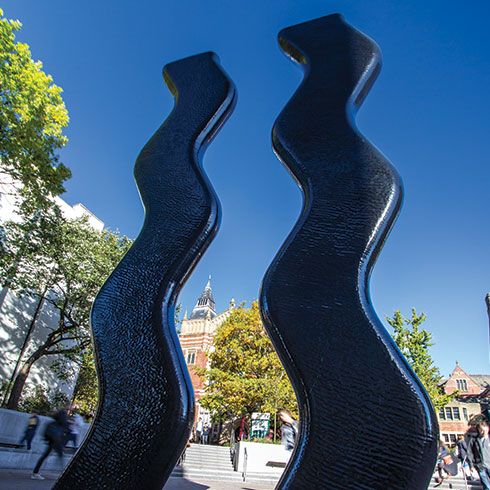
Sign for Art (Stelae 2014) references Wilson’s early years working as an art instructor for deaf-blind adults in the 1980s. ‘Drawing two spaced fingertips in a wave motion across the forehead of the student – a tactile brainwave sign – announced the arrival of the artist, the subject of art and the imminent activity of making art’, he remembered. ‘This modification of the British Sign Language, presumably derived from the making of a brushstroke, struck home and stayed with me’, he explained. Standing in the centre of the newly refurbished Beech Grove Plaza, the artwork has been affectionately christened by students ‘the squiggle’.
What3Words for Sign for Art artwork: ///lance.mice.early
The Dreamer
Quentin Bell was the son of Vanessa and Clive Bell and nephew of Virginia Woolf. He is renowned as a ceramicist artist and for his books on the Bloomsbury artists and a biography of Virginia Woolf. He was appointed Head of Fine Art at the University of Leeds in 1959, and later as Professor of Fine Art, until 1967.

In 1978, Stanley Burton suggested acquiring a work by Bell for the Leeds campus. Bell proposed a levitating figure – a recurrent theme in his art inspired by a conjuror’s trick he saw as a child – and suggested six potential locations. Stanley and the Vice-Chancellor, Lord Boyle, eventually decided upon a site near the Edward Boyle Library. The work was to be cast in fibreglass with a steel armature. An exciting inter-disciplinary partnership emerged with the Department of Civil Engineering. Dr. Gurdev Singh was responsible for the design and construction of the sculpture’s internal armature and the Department was responsible for the installation of the work, which was unveiled by Stanley Burton in October 1982. One of the most popular public artworks on campus, it has moved several times. It was removed from the Edward Boyle Library site due to the building expansion and was re-sited in the quiet courtyard of the Baines Wing coffee bar. More recently it has been relocated in the Clothworkers’ Court, so that it is more accessible to visitors. It is commonly known on campus as ‘The Dreamer’, but it is not clear when this title was acquired. It has also been called ‘The Astral Lady’, although Bell’s original notes make reference to the ‘Elmdon Figure’. Whatever its title or location, the artwork is now firmly a key element in shared memory and place-making experience on campus.
What3Words for the Dreamer artwork: ///steep.woes.flap
The Spirit of Enterprise
The flying bronze figure on the east wall of the Roger Stevens building is one of the most prominent, striking sculptures on campus. Originally it was commissioned by the Midland Bank for their London offices in the late 1950s. Chattaway called it Hermes, but his patrons suggested the work be re-named The Spirit of Enterprise because the Greek god Hermes had ‘a number of roles, including that of the guardian of less desirable characters’. In 1983, when the Midland building was sold to developers for £30m, it was rumoured that The Spirit of Enterprise was to be sold for scrap. The dilemma hit the national press. Into the breach stepped Chattaway’s longstanding patron, Stanley Burton, who sent a cheque to the University of Leeds to purchase the work for campus. The work, weighing four and a half tons, arrived on a low-loader from London and was installed that June. Chattaway was delighted to see the name of the piece revert to his original title, Hermes.

The blank wall is a perfect backdrop to dramatically display Hermes to best advantage and a far cry from its position in London. It is a dramatic example of how public art can change and adapt to new settings and new audiences, creating fresh dialogues with its environment.
What3Words for the Spirit of Enterprise: ///suffer.guilty.scar
Tree carving
This tree carving by Shane Green is based on an original design by Joely Holder – a maths student at the University. The carving deals with the theme of sustainability.
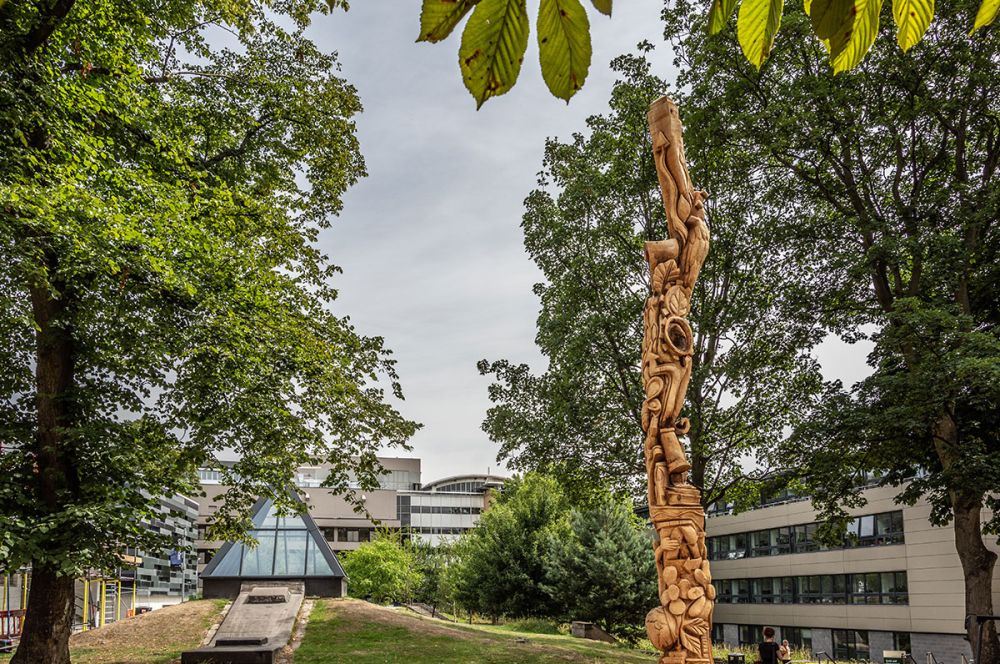
What3Words for the Tree Carving artwork: ///waddled.pinks.served
Walking Figure
William Chattaway was born in Coventry. He attended Coventry School of Art from 1943-5 and the Slade from 1945-8, before settling permanently in Paris in 1950. The original Walking Figure was created in 1968 and is much influenced by Alberto Giacometti’s walking figures of the 1950s and 60s. Chattaway explores the armless female form, considering spatial relationships and the concept of movement within a single, life-size work.
The original piece was conceived as part of a Triple Group (1968) with a seated figure and one lying horizontally. Stanley Burton had enjoyed a close friendship with Chattaway and had been elected to serve on the University of Leeds Council in 1952 and was subsequently appointed Chairman of Bodington Hall, the University’s new student hall of residence completed in 1963.
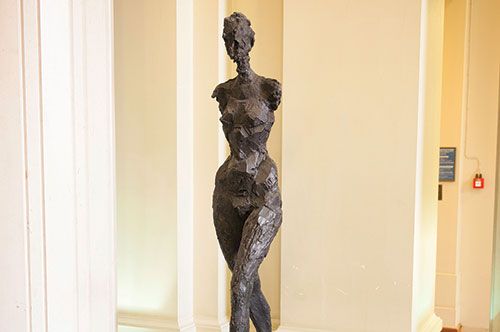
Stanley commissioned a replica of the version of the standing figure from the original triple group, which was installed outside in the grounds of Bodington Hall. In the 1980s, however, Walking Figure was severely damaged by students and one leg was destroyed beyond repair. Ever supportive of the University, Stanley intervened again and organised with Chattaway to recast the sculpture. This later cast is now displayed for security reasons within Parkinson Court, where it is seen by thousands of students, staff and visitors each year. Bodington Hall closed in 2013 and the damaged original sculpture was displayed in the garden of the Burton family home, Fulwith Brow.
What3Words for the Walking Figure artwork: ///search.engage.sprint
More information
What3words
What3words is a system designed to identify any location with three words. The developers divided the world into 3 metre squares and gave each square a unique combination of three words. Compared to current street addressing systems, what3words provides more accurate location information.
Many of the buildings and facilities on our map have a what3words location that you can view in your browser or using the free app. For more information visit What3Words